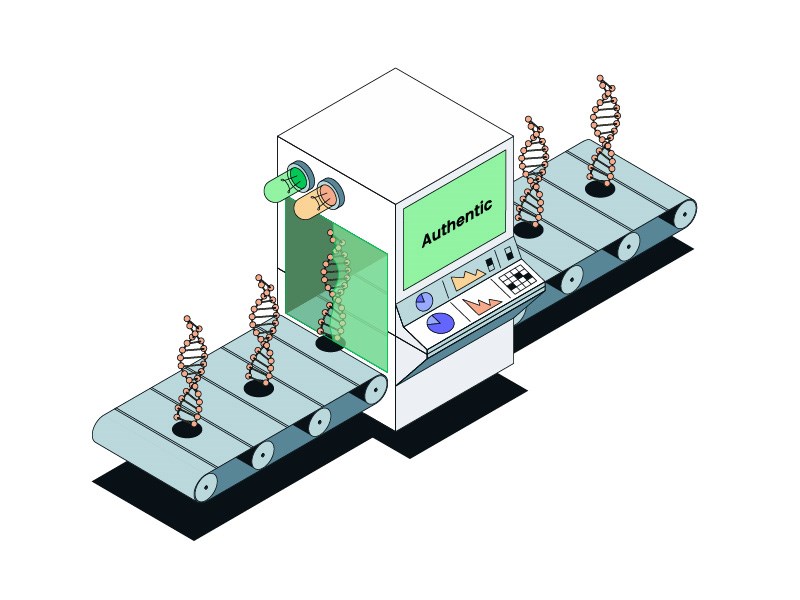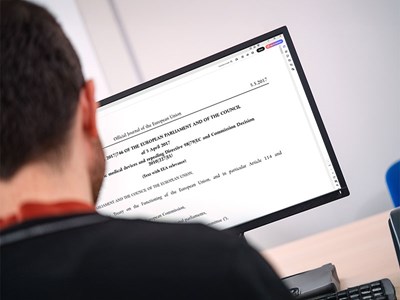Authenticity testing: DNA doesn't lie

Is it really what it claims to be? Discover how oligonucleotide-based authenticity testing helps verify the true identity and origin of biological materials: ensuring safety, traceability, and regulatory confidence across food, pharma, diagnostics, research, and beyond.
Why authenticity testing matters?
Authenticity testing plays a central role in ensuring safety, traceability, and regulatory compliance across multiple industries. It verifies that biological materials, reagents, or products are what they claim to be: a requirement for protecting public health, ensuring reproducibility, and maintaining brand trust.
- In research, misidentified cell lines can compromise data and invalidate entire studies.
- In food manufacturing, undeclared substitutions or mislabeling can lead to allergen exposure, regulatory non-compliance, or compromise consumer trust.
- In biopharma, raw material substitution may affect drug safety or result in failed audits.
- In diagnostic kit development, authenticity testing contributes to quality control: it ensures reagent integrity and consistency across lots, supporting Lab developed Tests (LDTs) and CE-IVD kit production.
- In forensics and legal investigations, DNA-based identification of biological samples supports applications such as paternity testing, disaster victim identification, or sample authentication in judicial contexts.
These use cases are increasingly supported by molecular technologies, especially PCR-based techniques using custom oligonucleotides. Their high sensitivity and specificity allow detection of target DNA even in degraded or complex samples, from processed food matrices to forensic evidence or cosmetic formulations.
Are oligonucleotides the only tool for authenticity testing?
Not entirely. While oligo-based methods (e.g. PCR, qPCR, dPCR, sequencing...) are highly effective for DNA-level identification and widely used in food, pharma, and diagnostics, other technologies also play a role depending on the analytical target:
- ELISA or lateral flow assays detect proteins, like allergens or marker enzymes.
- Mass spectrometry or chromatography may be used to verify chemical composition.
- Spectroscopic methods can support fingerprinting of complex compounds (e.g., in cosmetics or drugs).
Yet, DNA-based assays offer clear advantages when proteins or chemicals are degraded, or when precise identification of biological origin is needed.
The techniques behind the test
Different nucleic acid amplification (NAAmp) techniques support authenticity testing, each relying on the careful design and synthesis of oligonucleotides:
- qPCR: rapid and quantitative; ideal for species detection or microbial ID in routine testing.
- Digital PCR (dPCR): offers absolute quantification, even in low-copy samples or complex matrices.
- Multiplex qPCR: enables simultaneous testing of multiple targets: critical for analyzing blended food products.
- Sequencing / SNP Genotyping: Used for deeper verification or identification of subtle genetic differences.
- DNA Barcoding: Combines conventional PCR and sequencing of standard gene regions to identify species by comparing with reference databases. Common in food authentication and biodiversity control.
Custom oligonucleotides and fluorescent probes are essential for these assays, tailored to match the unique genetic signature of the target organism or sequence.
Why oligonucleotide quality is critical
Molecular authenticity testing relies on the performance of primers and probes to ensure accurate and reproducible results. Key aspects include:
- Specificity – ensuring that only the target sequence is amplified
- Sensitivity – allowing detection of low-abundance or degraded DNA
- Consistency – delivering reproducible results across batches and laboratories
Choosing oligos that meet the appropriate specifications for the intended application helps support assay robustness and compliance with analytical or regulatory standards.
DNA-based authenticity testing in practice
Oligonucleotide-based molecular assays are essential for verifying authenticity in fields where traceability, safety, and compliance are critical. Below are five real-world examples illustrating how these techniques support reliable quality control and risk mitigation.
1. Species identification in food, agriculture and beyond
DNA-based methods (qPCR, dPCR) are routinely used to verify that food and feed products match their declared contents. Species-specific oligonucleotides help detect substitutions, undeclared animal origins, or contamination. And this applies not only to food, but also to supplements and even premium goods authentication (e.g. real leather vs. synthetic) or cosmetics (e.g., aloe vera replaced by cheaper alternatives).
Case: Horse meat in beef products (2013)
In Europe, beef products were found to contain undeclared horse meat. qPCR testing enabled the identification of horse DNA, leading to widespread recalls and tighter regulatory controls.
2. Cell line authentication in biomedical research
Short Tandem Repeat (STR) profiling and PCR assays are used to confirm the identity of cell lines and rule out contamination or mislabeling, a key for reproducibility in basic and translational research.
Case: HeLa cell cross-contamination
HeLa cells, the first immortal human cell line, were derived in 1951 from the cervical tumor of Henrietta Lacks, a patient treated for cancer. These cells have been used in thousands of research projects due to their ability to divide indefinitely. However, their aggressive growth also led to widespread cross-contamination in labs, where HeLa cells unknowingly replaced other cell lines.This misidentification compromised the validity of many studies over decades until molecular authentication methods like STR profiling helped uncover and resolve the issue.
Horbach S, et al., PLoS One, 12: e0186281. (2017)
Souren N, et al., EMBO J, 41: e111307. (2022)
3. Verification of raw material origin in biopharma
Oligo-based assays help confirm the animal origin of ingredients like heparin, gelatin, or collagen which is essential for drug safety, regulatory compliance, and documentation in both human and veterinary medicine. Similar approaches are applied in cosmetics and nutraceuticals to authenticate animal or plant-based inputs.
Case: Heparin adulteration crisis (2008)
Commercially available heparin is derived from animal tissues, most commonly porcine intestinal mucosa. In 2008, a contaminated supply chain led to the replacement of porcine heparin with oversulfated chondroitin sulfate, a semi-synthetic polysaccharide not approved for pharmaceutical use. This adulteration resulted in over 80 deaths and hundreds of severe allergic-like reactions globally. The incident exposed critical weaknesses in raw material traceability and sparked international regulatory reform.
Today, molecular verification techniques, including DNA-based assays, help confirm the animal origin of heparin, supporting both safety and regulatory compliance in the U.S., EU, and beyond.
4. Detection of pathogens or GMOs in food and feed
PCR assays offer unmatched sensitivity for detecting microbial contaminants or genetically modified organisms (GMO). They're commonly used in quality control across the food chain (from crops to animal feed).
Case: GMO rice contamination in U.S. exports (2006)
In 2006, unapproved genetically modified rice (LL601) was detected in U.S. exports to Europe and Asia using PCR testing. The event triggered major import bans and economic disruption. Some GMO crops (like LL601) were not authorized for human consumption in certain regions due to insufficient safety data or concerns over environmental impact, allergenicity, or antibiotic resistance markers. As a result, their accidental presence, even in small quantities, violates regulatory thresholds and labeling laws.
GMO-CRL Rice LL601 Update-EU Comission
5. Verification of absence for labeling claims
DNA-based assays are increasingly used to confirm the absence of specific plant or animal sources in products labeled as gluten-free, peanut-free, halal or vegan. This is especially important in situations where even trace contamination can trigger severe or life-threatening anaphylactic reactions (e.g. peanuts), immune reactions, violate regulatory thresholds, or mislead consumers.
Case: Undeclared gluten in “gluten-free” products (2017)
A Canadian inspection campaign revealed that ~15% of foods labeled gluten-free contained gluten above thresholds. For individuals with celiac disease, even trace levels can trigger intestinal damage and long-term health issues. While gluten is a protein, qPCR assays targeting the mitDNA of gluten-producing cereals [such as Triticum (wheat), Hordeum (barley), and Secale (rye)] can detect contamination even when proteins have been degraded during food processing.
CFIA Gluten-Free Bakery Mixes Testing Report (2017)
Conclusion
DNA-based authenticity testing has become a cornerstone of quality control across food, pharma, diagnostics, research, and even forensic science. Custom oligonucleotides enable sensitive, specific, and reproducible assays to verify biological identity, detect substitutions, or confirm the absence of unwanted components. As molecular methods expand into new sectors, they continue to enhance traceability, compliance, and safety, wherever certainty matters.
Looking for reliable oligos for authenticity testing?
Discover our custom oligonucleotides for testing, designed to support molecular techniques like qPCR, dPCR, and multiplex PCR with the quality, flexibility, and documentation your lab needs.
Custom oligos for in-house assays
Need more sensitivity for your qPCR authenticity assays?
Try Takyon® Ultra: a robust, inhibitor-tolerant master mix for challenging samples.





